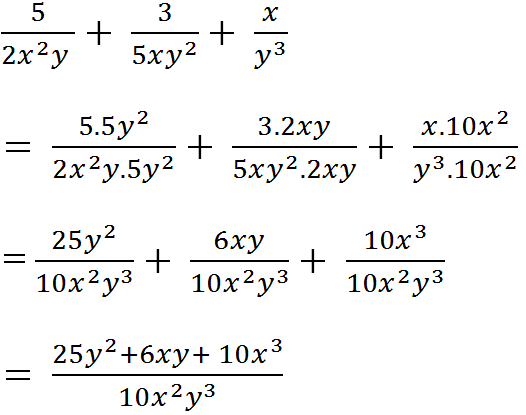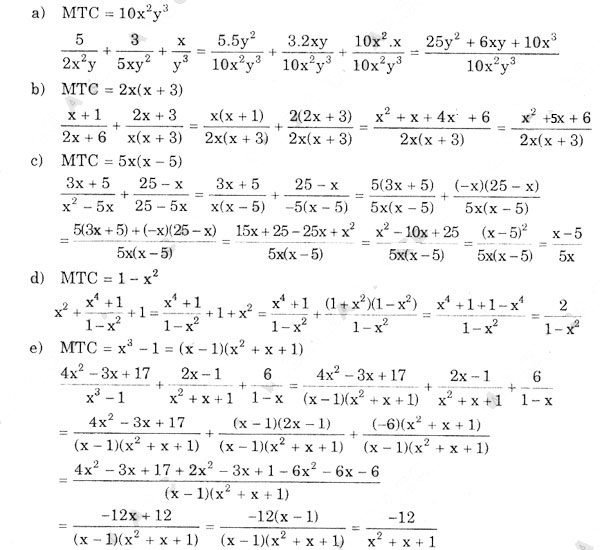Hãy nhập câu hỏi của bạn vào đây, nếu là tài khoản VIP, bạn sẽ được ưu tiên trả lời.

a)
\(\left\{{}\begin{matrix}x-1\ne0\\x+2\ne0\end{matrix}\right.\)
b)
x khác 1
c)
x khác 0; x khác 5
d) x khác 5 ; x khác -5

a, Ta có : \(\dfrac{98x^2-2}{x-2}=0\Leftrightarrow\left\{{}\begin{matrix}98x^2-2=0\\x-2\ne0\end{matrix}\right.\)
hay \(\left\{{}\begin{matrix}x^2=\dfrac{1}{49}\\x\ne2\end{matrix}\right.\Leftrightarrow x=\pm\dfrac{1}{7}\)
Vậy giá trị của phân thức này bằng 0 khi \(x=\pm\dfrac{1}{7}\)
b, Ta có : \(\dfrac{3x-2}{x^2+2x+1}=0\Leftrightarrow\dfrac{3x-2}{\left(x+1\right)^2}=0\Leftrightarrow\left\{{}\begin{matrix}3x-2=0\\\left(x+1\right)^2\ne0\end{matrix}\right.\)
hay \(\left\{{}\begin{matrix}x=\dfrac{2}{3}\\x\ne-1\end{matrix}\right.\)
Vậy giá trị của phân thức này bằng 0 khi \(x=\dfrac{2}{3}\)
a)
98x^2 -2 =0 =>x^2 =1/49 => x= -+1/7 nhận
b)
3x-2=0=>x=2/3 nhận

a, \(\dfrac{12}{x^2-4}-\dfrac{x+1}{x-2}+\dfrac{x+7}{x+2}=0\)
\(\Leftrightarrow\dfrac{12}{x^2-4}-\left(\dfrac{x+1}{x-2}-\dfrac{x+7}{x+2}\right)=0\)
\(\Leftrightarrow\dfrac{12}{x^2-4}-\left[\dfrac{\left(x+1\right)\left(x+2\right)-\left(x-2\right)\left(x+7\right)}{\left(x-2\right)\left(x+2\right)}\right]=0\)
\(\Leftrightarrow\dfrac{12}{x^2-4}-\left[\dfrac{x^2+3x+2-x^2-5x+14}{x^2-4}\right]=0\)
\(\Leftrightarrow\dfrac{12}{x^2-4}-\left(\dfrac{14-2x}{x^2-4}\right)=0\)
\(\Leftrightarrow12=14-2x\)
\(\Leftrightarrow x=1\)
Vậy x = 1

a) \(\dfrac{\left(x+1\right)^2}{x^2-1}-\dfrac{\left(x-1\right)^2}{x^2-1}=\dfrac{16}{x^2-1}\)
=>\(\left(x+1\right)^2-\left(x-1\right)^2=16\)
=>\(x^2+2x+1-x^2+2x-1=16\)
=>4x=16=>x=4
b)\(\dfrac{12}{x^2-4}-\dfrac{x+1}{x-2}+\dfrac{x+7}{x+2}=0\)
=>\(\dfrac{12}{x^2-4}-\dfrac{\left(x+1\right)\left(x+2\right)}{x^2-4}+\dfrac{\left(x+7\right)\left(x-2\right)}{x^2-4}=0\)
=>\(12-\left(x+1\right)\left(x+2\right)+\left(x+7\right)\left(x-2\right)=0\)
=>\(12-x^2-3x-2+x^2+5x-14=0\)
=>2x-4=0=>2x=4=>x=2
c)\(\dfrac{12}{8+x^3}=1+\dfrac{1}{x+2}\)
=>\(\dfrac{12}{8+x^3}=\dfrac{x^3+8}{x^3+8}+\dfrac{x^2-2x+4}{x^3+8}\)
=>\(12=x^3+8+x^2-2x+4\)
=>\(x^3+x^2-2x=0\)
=>\(x^3-x+x^2-x=0\)

a , \(16x^2+8x+1=\left(4x\right)^2+2.4x.1+1^2=\left(4x+1\right)^2\)
b , \(x^2-x+\dfrac{1}{4}=x^2-2.x.\dfrac{1}{2}+\left(\dfrac{1}{2}\right)^2=\left(x-\dfrac{1}{2}\right)^2\)
a,(4x+1)2 e,\(\left(\dfrac{3}{2}x-\dfrac{2}{5}\right)^2\)
b,(x-\(\dfrac{1}{2}\))2 g,\(\left(xy+1\right)^2\)
c,(\(x+\dfrac{3}{2}\))2 h,\(\left(x+5\right)^2\)
d,\(\left(x-\dfrac{5}{4}\right)^2\) i,\(-\left(x-6\right)^2\)
k,\(-\left(2x+3\right)^2\)

Bài 1:
a) \(\dfrac{3x^2-5}{x^2-5x}+\dfrac{5-15x}{5x-25}\)
\(=\dfrac{3x^2-5}{x\left(x-5\right)}+\dfrac{5\left(1-3x\right)}{5\left(x-5\right)}\)
\(=\dfrac{3x^2-5}{x\left(x-5\right)}+\dfrac{1-3x}{x-5}\)
\(=\dfrac{3x^2-5}{x\left(x-5\right)}+\dfrac{x\left(1-3x\right)}{x\left(x-5\right)}\)
\(=\dfrac{3x^2-5+x\left(1-3x\right)}{x\left(x-5\right)}\)
\(=\dfrac{3x^2-5+x-3x^2}{x\left(x-5\right)}\)
\(=\dfrac{-5+x}{x\left(x-5\right)}\)
\(=\dfrac{x-5}{x\left(x-5\right)}\)
\(=\dfrac{1}{x}\)
b) \(\dfrac{4+x^3}{x-3}-\dfrac{2x+2x^2}{x-3}+\dfrac{2x-13}{x-3}\)
\(=\dfrac{\left(4+x^3\right)-\left(2x+2x^2\right)+\left(2x-13\right)}{x-3}\)
\(=\dfrac{4+x^3-2x-2x^2+2x-13}{x-3}\)
\(=\dfrac{x^3-2x^2-9}{x-3}\)
\(=\dfrac{x^3-3x^2+x^2-9}{x-3}\)
\(=\dfrac{x^2\left(x-3\right)+\left(x-3\right)\left(x+3\right)}{x-3}\)
\(=\dfrac{\left(x-3\right)\left(x^2+x+3\right)}{x-3}\)
\(=x^2+x+3\)
c) \(\dfrac{2}{x-5}+\dfrac{x-25}{\left(x+5\right)\left(x-5\right)}\)
\(=\dfrac{2\left(x+5\right)}{\left(x+5\right)\left(x-5\right)}+\dfrac{x-25}{\left(x+5\right)\left(x-5\right)}\)
\(=\dfrac{2\left(x+5\right)+x-25}{\left(x+5\right)\left(x-5\right)}\)
\(=\dfrac{2x+10+x-25}{\left(x+5\right)\left(x-5\right)}\)
\(=\dfrac{3x-15}{\left(x+5\right)\left(x-5\right)}\)
\(=\dfrac{3\left(x-5\right)}{\left(x+5\right)\left(x-5\right)}\)
\(=\dfrac{3}{x+5}\)
d) Đề sai?
Bài 2:
\(A=2\left(x+1\right)+\left(3x+2\right)\left(3x-2\right)-9x^2\)
\(A=2x+2+9x^2-4-9x^2\)
\(A=2x-2\)
\(A=2\left(x-1\right)\)
Thay x = 15 vào A ta được:
\(A=2\left(15-1\right)\)
\(A=2.14=28\)

Câu 2:
ĐKXĐ: \(\left[{}\begin{matrix}1-9x^2\ne0\\1+3x\ne0\\1-3x\ne0\end{matrix}\right.\Rightarrow \left[{}\begin{matrix}x\ne\dfrac{-1}{3}\\x\ne\dfrac{1}{3}\end{matrix}\right.\)
\(\dfrac{12}{1-9x^2}=\dfrac{1-3x}{1+3x}-\dfrac{1+3x}{1-3x}\left(1\right)\)
\(\left(1\right):\dfrac{12}{\left(1-3x\right)\left(1+3x\right)}-\dfrac{\left(1-3x\right)\left(1-3x\right)}{\left(1-3x\right)\left(1+3x\right)}+\dfrac{\left(1+3x\right)\left(1+3x\right)}{\left(1-3x\right)\left(1+3x\right)}=0\)
\(\Leftrightarrow 12-\left(1-3x-3x+9x^2\right)+\left(1+3x+3x+9x^2\right)=0\)
\(\Leftrightarrow 12-1+3x+3x-9x^2+1+3x+3x+9x^2=0\)
\(\Leftrightarrow12x+12=0\\ \Leftrightarrow12x=-12\\ \Leftrightarrow x=-1\left(TM\right)\)
Vậy \(S=\left\{-1\right\}\)



a)
2x-3=0 => x=3/2
b)
2x^2 +1 =0 => vô nghiệm
c) x^2 -25 =0 => x=5 loiaj
x=-5 nhân
d)
x^2 -25 =0 => x=5 loại
x=-5 loại